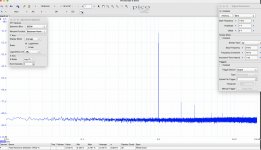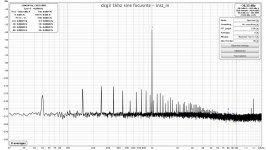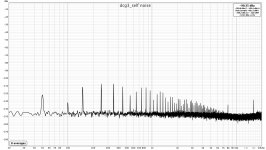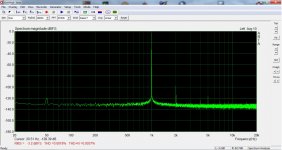From the +17V output a green LED >|
From the -17V output a green LED |<
If the consumption is up to +/- 20mA, each one will drop about 2V and will not be overpowered
From the -17V output a green LED |<
If the consumption is up to +/- 20mA, each one will drop about 2V and will not be overpowered
It is better to provide muses with an external 5v ps, for the microcontroller, not the on board 5v reg.
Of course you must set the jumper, on muses board, accordingly.
Of course you must set the jumper, on muses board, accordingly.
No change in "setup".
Just tried a new measurement using Picoscope 4226 - 12bit.
Looks fine but I guess it is has not got the resolution for this.
20khz squarewave also added
Actually wondering if I got som gnd issues between the dcg3 and the focusrite soundcard that causes the 50hz odd harmonics?
That would be nice 🙂
Just tried a new measurement using Picoscope 4226 - 12bit.
Looks fine but I guess it is has not got the resolution for this.
20khz squarewave also added
Actually wondering if I got som gnd issues between the dcg3 and the focusrite soundcard that causes the 50hz odd harmonics?
That would be nice 🙂
Attachments
Last edited:
Lost in translation here. Tried another input on the soundcard. (inst_in).
It has not got the same resolution but still good.
The odd harmonics are 110dB down.
Also attached its selv noise at that input, and I am not sure if whether these harmonics in fact now is caused by the "measurement setup" (gnd loop between boxes) and not by the dcg3 itself.
I havent got a doctors degree in measurements to be honest.
It has not got the same resolution but still good.
The odd harmonics are 110dB down.
Also attached its selv noise at that input, and I am not sure if whether these harmonics in fact now is caused by the "measurement setup" (gnd loop between boxes) and not by the dcg3 itself.
I havent got a doctors degree in measurements to be honest.
Attachments
Last edited:
Connect the dcg3 output only to the Focus (no signal loop) and run noise floor to see if the same harmonics are there
The odd harmonics are 110dB down.
Difficult to hear them directly at that -dB level, but better to clear them if possible, the subjective resolution is usually going up a notch when cleared.
2 measurements. Nothing connected to the dcg3.Connect the dcg3 output only to the Focus (no signal loop) and run noise floor to see if the same harmonics are there
1. XLR in on soundcard (mic in)
2. Instrument in on soundcard
The harmonics are there but not as severe as yesterday 😉
Have not tried feeding the muses72320 from other PSU yet. Weekend now and have to wait until next week
Attachments
Hi Salas,
I see some members are going towards DCG3 in balance architecture and I just wander (guess some other guys might seeking same info) about benefits of such in general. If the main goal is to deliver clean signal from source to destination via deferential signal approach, then why not to use converts or each side. They are small, easy to construct and relatively cheap. In other words, it is way cheaper way compare to double build. So, what are others, beside box2box "clean" signal delivery, significant benefits will be with balanced setups?
I see some members are going towards DCG3 in balance architecture and I just wander (guess some other guys might seeking same info) about benefits of such in general. If the main goal is to deliver clean signal from source to destination via deferential signal approach, then why not to use converts or each side. They are small, easy to construct and relatively cheap. In other words, it is way cheaper way compare to double build. So, what are others, beside box2box "clean" signal delivery, significant benefits will be with balanced setups?
2 measurements. Nothing connected to the dcg3.
1. XLR in on soundcard (mic in)
2. Instrument in on soundcard
The harmonics are there but not as severe as yesterday 😉
Have not tried feeding the muses72320 from other PSU yet. Weekend now and have to wait until next week
I got similar problem on my DCG3 with 20K Khozmo relay based unit. Also used Focusrite 2i2 3rd gen card. My Khozmo required 5V 1A (it is not constant current draw and based on position, but I saw 0.6A in use max) separate PSU for norm operation. So, I use separate PSU for that attenuator provided by Khozmo for free. It was GND loop and found way to interrupt it. I fully insulated Khozmo PSU 0V from Earth and make it run floating. I also Earthed attenuator shaft. Ran all signal GNDs separate (even did not use PCB GNDs in i-Select). Signal GNDs (L and R) are met at headphone panel connection GND lug and from that point I connected signal GND to safety Earth/chassis via Rod Elliot style “lifter”. I also used thick Mu metal cylinders on my two toroids, but that was not the cause of that specific noise. Small 60hz (I’m in US) pick plus its harmonics was defeated by some Mu Metal and Cu shield that I placed on IEC connector (it was advice from Ricardo and it worked out for me).
Hi Salas,
I see some members are going towards DCG3 in balance architecture and I just wander (guess some other guys might seeking same info) about benefits of such in general. If the main goal is to deliver clean signal from source to destination via deferential signal approach, then why not to use converts or each side. They are small, easy to construct and relatively cheap. In other words, it is way cheaper way compare to double build. So, what are others, beside box2box "clean" signal delivery, significant benefits will be with balanced setups?
I use a doubled built -4 SE channels- as independent buffers, no input or output converters. Imagine something working on this principal https://www.ti.com/lit/an/sbaa267a/...55959&ref_url=https%3A%2F%2Fwww.google.com%2F CMRR and necessary conversions will happen at the differential amp inputs. I used torroids with magnetic shield. A tiny 50Hz spike doesn't seem to propagate since DCSTB is free from 100Hz noise. Having it working at 6x without input attenuator at all, I'm very happy with it. Attached FFT is at 400mV in, 2,6V out on 600 ohm headphones.
Attachments
Attached FFT is at 400mV in, 2,6V out on 600 ohm headphones.
Very clean
I see some members are going towards DCG3 in balance architecture and I just wander (guess some other guys might seeking same info) about benefits of such in general. If the main goal is to deliver clean signal from source to destination via deferential signal approach, then why not to use converts or each side. They are small, easy to construct and relatively cheap. In other words, it is way cheaper way compare to double build. So, what are others, beside box2box "clean" signal delivery, significant benefits will be with balanced setups?
There are a few reasons to favor a fully balanced implementation.
Any noise picked up by the preamp circuitry is likely to be picked up similarly by the two halves of the balanced pair, and will then be cancelled by the differential input of the amplifier (or balanced headphones).
Circuit non-linearities that are common between the two halves are cancelled out. This will significantly reduce even order harmonics, making the predominant harmonic the third (which sounds the same to the ear as the second), but at reduced magnitude, with lower higher order harmonics. This will also reduce compounded distortions downstream if the dcg3 is being used as a line stage.
Adding a conversion stage after the dcg3 to convert to balanced will lose some or all the benefits of the high drive capability of the high bias output stage.
Obviously the downside is a more complex and expensive implementation.
If I can play the devil's advocate for a moment, what's the practical benefit of going balanced? DCG3 is already dead quiet and incredibly transparent sounding. If you have internal noise problems, these can be solved with careful layout and grounding.
DCG3 has very low distortion. Can you build the two halves to be so well-matched that you meaningfully reduce even-order distortion without introducing new distortions?
Most headphones are unbalanced anyway, but if you have a pair that allows four-wire cabling, you can accommodate that with a single DCG3 board.
Do you have an actual problem that you need to solve with a balanced amplifier?
I definitely don't want to sound like I'm criticizing anyone. Balanced is cool and the fun of the hobby is trying different things. I do know there are respected engineers who make a compelling case for balanced circuitry.
IMHO, if you require balanced inputs to solve a particular problem, the best bet would be to put a very clean op-amp instrumentation amplifier in front of the DCG3. Or use a transformer. Otherwise, take the DCG3 and redesign it from the ground-up as a balanced circuit.
Just my two cents. I'm not quite a total DCG3 fanboi, but I'm very satisfied with how this thing works as-is. I think at a minimum anyone who's thinking of building a balanced DCG3 should consider making a conventional one first. Then you can compare and post how the two compare.
Again, not trying to rain on anyone's parade. Experimentation is awesome.
-Henry
DCG3 has very low distortion. Can you build the two halves to be so well-matched that you meaningfully reduce even-order distortion without introducing new distortions?
Most headphones are unbalanced anyway, but if you have a pair that allows four-wire cabling, you can accommodate that with a single DCG3 board.
Do you have an actual problem that you need to solve with a balanced amplifier?
I definitely don't want to sound like I'm criticizing anyone. Balanced is cool and the fun of the hobby is trying different things. I do know there are respected engineers who make a compelling case for balanced circuitry.
IMHO, if you require balanced inputs to solve a particular problem, the best bet would be to put a very clean op-amp instrumentation amplifier in front of the DCG3. Or use a transformer. Otherwise, take the DCG3 and redesign it from the ground-up as a balanced circuit.
Just my two cents. I'm not quite a total DCG3 fanboi, but I'm very satisfied with how this thing works as-is. I think at a minimum anyone who's thinking of building a balanced DCG3 should consider making a conventional one first. Then you can compare and post how the two compare.
Again, not trying to rain on anyone's parade. Experimentation is awesome.
-Henry
Balanced certainly isn't for everyone. If you're looking for best bang for the buck, a single ended implementation makes a lot more sense.
I've found that balanced provides just that little extra detail and clarity that it's worth it for me (although I haven't heard a balanced DCG3, so can't comment how well that will work).
I run fairly long interconnects to my monoblock amps, which also have differential inputs, since I like to position my equipment (other than amps) on the side of the room and use very short speaker cables. In my case, it's not just about sonics, although I have found that decluttering the space between the speakers improves the depth and specificity of the sound stage. I have a set of french doors centered on the wall between the speakers that I want clear access to and it's a lot easier to hide a single balanced cable than thick speaker cables.
I've found that running balanced reduces the impact of the cables (e.g., there is less difference between really good cables and so-so cables), particularly for longer cable runs (mine are about 8 meters). This doesn't mean that you can't hear the difference between cables, but it is more subtle than the differences with single ended. Also, since switching to balanced several decades ago (except for the occasional experiment), I've had zero hum issues.
I've found that balanced provides just that little extra detail and clarity that it's worth it for me (although I haven't heard a balanced DCG3, so can't comment how well that will work).
I run fairly long interconnects to my monoblock amps, which also have differential inputs, since I like to position my equipment (other than amps) on the side of the room and use very short speaker cables. In my case, it's not just about sonics, although I have found that decluttering the space between the speakers improves the depth and specificity of the sound stage. I have a set of french doors centered on the wall between the speakers that I want clear access to and it's a lot easier to hide a single balanced cable than thick speaker cables.
I've found that running balanced reduces the impact of the cables (e.g., there is less difference between really good cables and so-so cables), particularly for longer cable runs (mine are about 8 meters). This doesn't mean that you can't hear the difference between cables, but it is more subtle than the differences with single ended. Also, since switching to balanced several decades ago (except for the occasional experiment), I've had zero hum issues.
Yeah, definitely. I think one of the best use cases for balanced is when you put monoblocks next to the speakers and run long interconnects. The ground loop area (including mains ground) in that case is huge.
-Henry
-Henry
Hi,
Yes they will both work. The 2SA970BL has different pin out than the board's and its a more linear higher beta lower noise transistor than the BC556B. But beware of fakes.
Yes they will both work. The 2SA970BL has different pin out than the board's and its a more linear higher beta lower noise transistor than the BC556B. But beware of fakes.
Thank you for your quick response. That's why I'm asking, because I have the original 970. They were left after The End Millennium amp was assembled. If you do not pay attention to the pinout, then 2SA970 will be preferable? Choose a pair with a spread of no more than 5%. And within what limits it should (preferably) be the hFE of the transistors? Sorry for my English. I use a translator.
Thanks for helping out. Will look into some more tomorrow I guess.I got similar problem on my DCG3 with 20K Khozmo relay based unit. Also used Focusrite 2i2 3rd gen card. My Khozmo required 5V 1A (it is not constant current draw and based on position, but I saw 0.6A in use max) separate PSU for norm operation. So, I use separate PSU for that attenuator provided by Khozmo for free. It was GND loop and found way to interrupt it. I fully insulated Khozmo PSU 0V from Earth and make it run floating. I also Earthed attenuator shaft. Ran all signal GNDs separate (even did not use PCB GNDs in i-Select). Signal GNDs (L and R) are met at headphone panel connection GND lug and from that point I connected signal GND to safety Earth/chassis via Rod Elliot style “lifter”. I also used thick Mu metal cylinders on my two toroids, but that was not the cause of that specific noise. Small 60hz (I’m in US) pick plus its harmonics was defeated by some Mu Metal and Cu shield that I placed on IEC connector (it was advice from Ricardo and it worked out for me).
However after doing some reading different places I am starting to believe that maybe its the focusrite itself that can cause this. It is somewhat prone to pick up 50hz and also its harmonics.
Some other have had similar issues albeit with former generation soundcards.
Like this
https://www.diyaudio.com/forums/equ...2nd-gen-measurements-whats-5.html#post5029760
Especially this
https://www.diyaudio.com/forums/equ...2nd-gen-measurements-whats-4.html#post4965244
https://www.diyaudio.com/forums/equ...2nd-gen-measurements-whats-4.html#post4965443
https://www.diyaudio.com/forums/pow...z-350-hz-noise-linear-psu-10.html#post6412128
To name a few. Will look into cabling (using RG62 coax , diy xlr to rca but it is a couple of metres long) and a TRS (balanced jack - to rca, shorter cable with ferrites etc and the result with that setup was better) to test with 2 different inputs on the soundcard.
For what I know, the dcg3 could in fact be just perfect and its my equipment picking up stuff?
Thank you for your quick response. That's why I'm asking, because I have the original 970. They were left after The End Millennium amp was assembled. If you do not pay attention to the pinout, then 2SA970 will be preferable? Choose a pair with a spread of no more than 5%. And within what limits it should (preferably) be the hFE of the transistors? Sorry for my English. I use a translator.
Its a great transistor if you can twist the pins to fit. Has both the benefits of BC560C and BC327-40 while even more linear. Use Hfe pairs of no less than 400 if you have.
- Home
- Source & Line
- Analog Line Level
- Salas DCG3 preamp (line & headphone)






